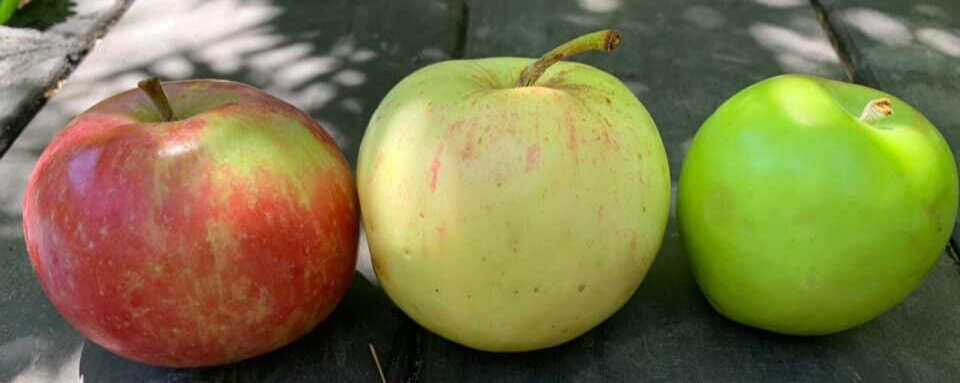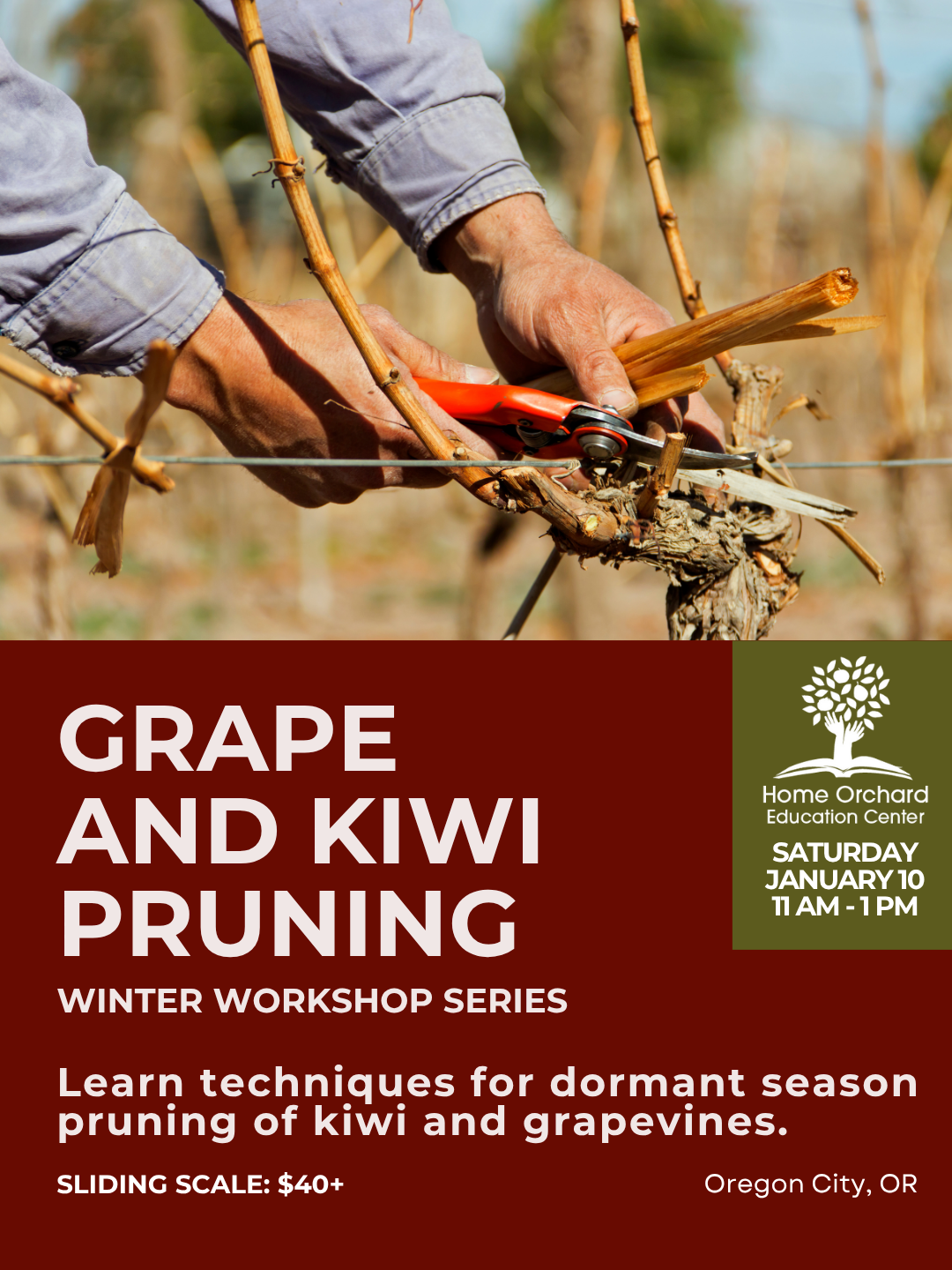How And When To Harvest Apples & Pears
When learning about the proper time to harvest fruits, it is important to first know the difference between the following words:
The white powder you see on these European pears is a Kaolin clay spray approved for use in Organic orchards, used to protect fruit from sunburn and pests.
Mature & Ripe
Some fruits must be picked when mature (but not yet ripe) and others are harvested only once they are ripe.
Mature fruit is full sized and has completed its growth cycle. However, it is has not yet gone through the ripening process to reach its peak flavor potential or most desirable texture. Fruits that are harvested only when mature, must be physiologically capable of continuing the ripening process after being harvested from the tree. This is called being “climacteric”. Climacteric fruits continue to ripen after being picked, and "non-climacteric” fruits do not.
Ripe fruit is already at or near its peak for texture and flavor; it is ready to eat.
EUROPEAN PEARS
European Pears do NOT ripen on the tree and are picked when they are mature.
This is because they have a sneaky habit of breaking down from the inside out, and nearly all varieties require exposure to cold temperatures for initiation of the ripening process. (There are of course some exceptions, but this is the general rule.) When left on the tree too long they begin to soften and rot from the center long before they are soft on the outside.
But never fear! European Pears ARE climacteric, and when picked at maturity they will successfully complete their ripening process off of the tree after a brief period of cold storage.
Maturity Indicators: How To Tell When European Pears Are Ready To Harvest
Remember we are looking for maturity with European Pears NOT ripeness
Feel
The texture of a mature European Pear will shift slightly from "very hard" to "firm". Close your hand around one of the pears still hanging on the tree and squeeze. You should be able to detect a slight feeling of give, but not too much. If it feels rock hard, it's probably not quite ready to be harvested
The “Cradle Test”
Most European pears that are ready for harvest should snap away easily from the branch with a little twist of the wrist. Take the pear in your hand and gently tilt up and away from you while giving it a very slight twist. If it is ready for picking, it should pop off the branch with the stem intact. If it is not yet ready for picking, it will hold on to the branch OR be difficult to remove. There are a few varieties that are an exception to this rule and are notoriously hard to remove even when mature - Bosc is one example.
Fruit Drop
Do you see full sized healthy fruit beginning to fall on the ground under the tree? This may be a clear indicator that those stems are popping off easily and that it’s time to get picking!
Seed Color
What color are the seeds? As pears mature,the color of almost all European Pear seed coats change from white, to beige, to dark brown or black.
NOW TAKE THE GUESS WORK OUT OF NEXT YEARS HARVEST!
An attentive orcahrdist would be smart to record the date of harvest and, if you want to get really fancy, the date of full bloom. “Full bloom” is defined as the day 60% of “king blossoms” are open on the north side of the tree.
Each variety of fruit naturally has a set number of days that come between full bloom and maturity or ripeness. This is called Days after full bloom (DAFB) and as a rule of thumb it should stay pretty similar each year. DAFB is often very accurate, but keep in mind it is not a foolproof system and you will want to use it as a baseline, combining this knowledge with other ripeness indicators.
So see if you can remember to record both the full bloom dates and the harvest dates of your fruit trees. This should give you a good baseline estimate of when to start checking more closely for maturity the following harvest season.
ASIAN PEARS
Unlike their sneaky relatives above, Asian Pears DO ripen on the tree, and so they are harvested once fully ripe.
Sounds easier, right!? Well not so fast my friend because we face another challenge here, and that is…..
ASIAN PEARS ARE VERY DELICATE
You may have seen them wrapped up individually in a plush and cozy little Asian Pear shaped sleeping bag at the grocery store? Perhaps you also noticed that the stems were cut very short to lessen the chance they may poke through the skin of another pear.
IMPORTANT HARVEST NOTE
Because these special treats have thin delicate skin, when harvesting we carefully cut off the stems and gently place them right into shallow crates ~ no pulling them off the tree and no dumping them into wheelbarrows or burying them under other pears in harvest bags!
RIPENESS INDICATORS: HOW TO TELL WHEN ASIAN PEARS ARE READY TO HARVEST
Smell-O-Vision
The key to ripeness with Asian Pears is - aroma! Asian pears are meant to be eaten when crisp and should still be quite firm when they are fully ripe, so while your pear won’t feel soft to the touch, the scent can help determine if it is ready to eat on the inside. A ripe Asian pear should give off a strong sweet aroma.
Color
Color can be an indicator of readiness. Japanese pears will usually have turned a yellowish / brown, while those with roots in China will show a greenish / yellow color.
Taste Test: So if your Asian pear smells delicious, and has the appropriate color, the next step is a taste test! Ripe fruit should be crisp, crunchy, sweet, and hopefully a bit juicy.
Fruit Drop
Do you see full sized healthy fruit beginning to fall on the ground under the tree? This may be a clear indicator that it is time to get picking!
Seed Color
What color are the seeds? As pears mature, the color of almost all seed coats change from white, to beige, to dark brown or black.
HARVESTING DIFFERENCES
European Pears
Harvested when mature.
Color can be an indicator of maturity if you are familiar with each variety, however different varieties turn different colors, so you will need to know what to look for with each type.
Harvested by gently “lifting & twisting” keeping the stem attached to the fruit.
Okay to harvest into bins, harvest bags, or wheelbarrow.
Asian Pears
Harvested only when fully ripe
Color is often a helpful indicator of ripeness. Japanese pears will usually have turned a yellowish / brown, while those with roots in China will show a greenish / yellow color.
Harvested by gently snipping the stem of the fruit from the branch.
Harvest gently in into flats. Snip the stem short and keep in a single layer when possible.
APPLES
Apples are harvested when ripe, and different varieties of apples are ripe at different times of the year.
Here in the HOEC Arboretum, the earliest apples are ready for picking in July and the latest aren’t ripe until October or November.
While specific cultivars will always ripen at about the same time each year, many factors can influence exact ripening dates, so don’t rely only on your calendar - you will need to know and look for a variety of different ripeness indicators before picking your tree clean.
Three of the earliest apples to ripen in the arboretum this year: Red Astrachan, Irish Peach, & Mantet. Followed up by Duchess of Oldenburg, Gravenstein, & Redfree.
Harvesting too early: can result in apples that are undersized, lacking peak flavor, and are subject to bitter pit and storage scald.
Harvesting too late: can result in apples that are soft or mushy, increases the potential development of water-core, and reduces the storage life of the fruit.
Maturity Indicators: How To Tell When Apples Are Ready To Harvest
Skin Color
Color can be a useful indication of maturity. Depending on the variety, apples may be yellow, red, green, gold, or any combination of these colors at harvest. You will need to know what color(s) the variety of apple you are harvesting is supposed to be in order for color to be a useful indicator.
The “Cradle Test”
Similar to European pears, an apple that is ready for harvest should snap away easily from the branch with a little twist of the wrist. There are a few varieties that are exceptions to this rule and are notoriously hard to remove even when ready. Take the apple in your hand and gently tilt it up and away from you while giving it a very slight twist. If it is ready for picking, it should pop off the branch with the stem intact. If it is not yet ready for picking, it will hold on to the branch OR be difficult to remove.
Fruit Drop
Do you see full sized healthy fruit beginning to fall on the ground under the tree? This may be a clear indicator that it is time to get picking!
Seed Color
What color are the seeds? As apples mature, the seed coat in many cultivars will change from white, to beige, to dark brown. However, some apples (especially many early ripening varieties) retain a naturally light seed, so this test is not always a good indicator of ripeness on its own.
Taste Test: Another good way to test for ripeness is simply to taste your apple! This is easier if you know what that specific variety is supposed to taste like, but still helpful even if you do not.
As an apple ripens, it converts starches into sugars. If the apple still tastes starchy, it is not yet ready to be harvested.
If the apple has a mushy or mealy texture, you may have missed the optimal window and it could already be over-ripe.
NOTE FOR HOEC STUDENT & VOLUNTEER HARVESTERS:
If you are uncertain if the fruits on any tree you are helping harvest are truly ready to be picked, make sure to check in with your friendly arboretum manager or designated volunteer lead before picking. Better to double check first than to harvest an entire tree of under ripe fruit that will not develop further once removed from the tree!
Can’t wait to share the bounty with you all this summer!

















